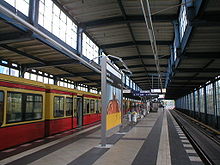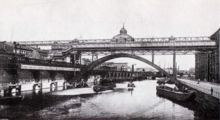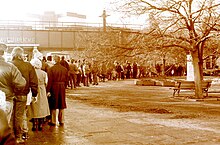Berlin Jannowitzbrücke train station
| Berlin Jannowitz Bridge | |
|---|---|
|
The train station from the outside
|
|
| Data | |
| Operating point type | Breakpoint |
| Platform tracks | 2 |
| abbreviation | BJB |
| Price range | 4th |
| opening | February 7, 1882 |
| Profile on Bahnhof.de | Jannowitzbruecke |
| location | |
| City / municipality | Berlin |
| Place / district | center |
| country | Berlin |
| Country | Germany |
| Coordinates | 52 ° 30 '53 " N , 13 ° 25' 6" E |
| Height ( SO ) | 38 m |
| Railway lines | |
| Railway stations in Berlin | |
The S- and U-Bahn station Jannowitzbrücke is located on the bridge of the same name in Berlin 's Mitte district and is a crossroads for local public transport . To the south of the train station is the Brückenstrasse, to the north the Holzmarktstrasse and the Alexanderstrasse. The station also serves as a stopping point for various private excursion and sightseeing ships, including those operated by Stern and Kreisschiffahrt and the Riedel shipping company .
S-Bahn station
When the Jannowitzbrücke was rebuilt (1881–1883), the suburban train station was opened at the same time on the Stadtbahn viaduct right next to the Spree . The official opening date is February 7, 1882. As the stop was only given an open platform roof, passengers were increasingly exposed to the weather and smoke from the locomotives. In 1885, the station received its first weather protection in the form of a glass wall, which was built between the suburban and long-distance track pair. The glass wall and the existing platform roof were connected by a roof, so that the construction of a platform hall that was half open to the north was created.
The traffic of the light rail increased steadily and the narrow central platform of the suburban train station Jannowitzbrücke had to be widened. In order to obtain enough space, the long-distance traffic tracks were moved slightly towards the south in 1906/1907, so that they now lay directly above the Spree thanks to a load-bearing structure. In 1997 the construction was changed slightly to increase stability.
When the new system of the S-Bahn had proven itself and electric trains were to run on the Stadtbahn from 1928, the station was demolished and rebuilt in its current form from 1927 to 1932 according to plans by the architect Hugo Röttcher . From June 11, 1928, S-Bahn trains also ran in the newly built station.
At the end of the Second World War , the S-Bahn had to cease operations in April 1945. From November 15, 1945, S-Bahn trains were running again, and traffic increased steadily due to the possibility of changing from S-Bahn and U-Bahn . Since the building of the Wall on August 13, 1961, this possibility of changing has no longer existed: references to the U-Bahn were removed and the Jannowitzbrücke station became a “simple” S-Bahn station. As early as November 11, 1989 - a few days after the political change - it was again possible to change between the S-Bahn and the U-Bahn.
After that, a thorough renovation of the light rail was due. The S-Bahn ran on the disused long-distance tracks outside the S-Bahn hall, so that they could not stop there. This made it possible to completely renovate the S-Bahn station from November 15, 1994 to October 21, 1996. Since then, an elevator, several escalators and shops have enriched the station.
Since the end of 2015, train handling has been carried out by the driver using the driver's cab monitor (ZAT-FM).
Subway station
After the decision had been made in Berlin to build a new rapid transit system at the end of the 19th century, various proposals were received. In addition to the subway system built later by Siemens , there was also the idea of a suspension railway , as had already been built in Wuppertal , for example . For this purpose, a suspension railway station Jannowitzbrücke was also considered. For aesthetic reasons, however, the city fathers of Berlin rejected this system and favored the subway system from Siemens and the AEG .
In 1907 the AEG presented plans for a new underground line from Rixdorf (today: Neukölln) to Gesundbrunnen . The negotiations with Berlin were very tough until the two parties were finally able to agree on a contract in 1912. After AEG-Schnellbahn-AG, a subsidiary of AEG, had to file for bankruptcy and was liquidated as a result of the First World War and the subsequent economic crisis , the city of Berlin took over the previously constructed underground structures, including the Spree underpass at the Jannowitz Bridge. However, this was not under the Jannowitz Bridge as it is today, but under the Waisenbrücke . This section of the tunnel was later converted into an operating tunnel. In addition, the city corrected the route again, for example at Alexanderplatz, in order to achieve a better connection.
On April 6, 1928, the route Schönleinstraße - Neanderstraße of today's U8 was opened. As already mentioned, the course had to be corrected. Since the Jannowitz Bridge was in poor condition, it was replaced by a new building. Since the Jannowitz Bridge could not be used, road traffic was diverted over the nearby orphan bridge. A temporary bridge had to be built for pedestrians. Finally, on April 18, 1930, the Neanderstraße - Gesundbrunnen section with the Jannowitzbrücke underground station was opened.
During the Second World War , the station hardly suffered any damage, it only had to be closed during the " final battle ". This was the case from April 1945 to June 16, the former line D - now the U8 - was the first of all lines to be used in full length and in circulation on the Gesundbrunnen – Leinestrasse route on June 16 .
16 years later, on August 13, 1961, the station had to be closed again. This time not just for a few months, but for more than 28 years. The station became a " ghost station " due to the construction of the wall . At that time, the trains simply drove through; Line D never stopped in East Berlin . The entrances to the S-Bahn , which was two levels higher, were completely walled up, only a faint rumble could be heard. Incidentally, on this route, as on the underground line C (today: U6), only the trains of the oldest series were used, as the BVG (West) feared that the GDR would in an action new trains over the orphan tunnel to the east -Berlin could kidnap.
At the time of reunification , the Jannowitzbrücke underground station played a very important role again: just two days after the fall of the Berlin Wall , the underground station was reopened as a border crossing point on November 11, 1989, for which the mezzanine floor between the underground and the S-Bahn was suitable.
The station thus took on an important role in border traffic: East Berliners who had traveled by S-Bahn could now get to West Berlin center via Hermannplatz with the U7 . Months later, on July 1, 1990, with the monetary, economic and social union between the two German states, border controls also ceased. Thus the station could be used again without restrictions.
In 2002 and 2003, the ceiling of the station was renovated, the lighting was replaced and the passenger information system “ DAISY ” was added. On January 19, 2009, the general renovation of the platform began, during which the side of the platform in the direction of Hermannstrasse was completely renewed and provided with a guidance system for the blind in the first construction phase by May 3 . From May 4 to July 23, 2009, the side towards Wittenau followed in the second construction phase . The opening was only planned for August 13, but in order to alleviate the restrictions on S-Bahn traffic (no traffic on the light rail), the station was opened earlier.
In a second phase of the station renovation, the southern vestibule is to be renovated, an elevator installed and an exit in the direction of Holzmarktstrasse opened. There are also plans to open a new service center. The station furniture should be replaced by mid-2010 and the tiles in the back track area and on the platform (pillars, etc.) should be replaced. The renovation work has now been completed.
On December 22, 2017, an elevator from the subway platform to the street surface was put into operation, so that since then, barrier-free access to the platform has been possible. On December 20, 2018, the converted exit at the corner of Alexanderstraße and Holzmarktstraße, which had been rotated by 90 degrees, was reopened.
Connection
The station is served by four lines of the Berlin S-Bahn and the U-Bahn line 8 . You can also change to bus line 248 operated by the Berlin transport company.
literature
- La Baume: The renovations at Jannowitzbrücke station in Berlin. In: The construction technology . 9th year. Issue 18 (April 24, 1931) and issue 19 (May 1, 1931), pp. 255-258 and 271-275.
- AB Gottwaldt, S. Nowak: Berlin train stations, then and now . Düsseldorf 1991, ISBN 3-87094-342-4 .
- Jürgen Meyer-Kronthaler: Berlin's subway stations - the first hundred years . be.bra, Berlin 1996, ISBN 3-930863-16-2 .
- Jürgen Meyer-Kronthaler, Wolfgang Kramer: Berlin's S-Bahn Stations - A Three-Quarter Century . be.bra. Verlag, Berlin 1998, ISBN 3-930863-25-1 .
- Norbert Schmidt: Berlin traffic locations through the ages - Jannowitzbrücke. Traffic history sheets . 31st year. No. 5 (September 2004) and No. 6 (November 2004), pp. 118–129 and 163–171.
Web links
- Entry in the Berlin State Monument List with further information
- BVG map of the station (PDF; 313 kB)
- Jannowitzbrücke station on stadtschnellbahn-berlin.de
- Description of the Jannowitzbrücke – Gesundbrunnen underground line (including pictures of the station)
- Pictures from the underground station on untergrundbahn.de
Individual evidence
- ↑ Profile of the station on firmendb.de
- ↑ Jürgen Meyer-Kronthaler, Wolfgang Kramer: Berlin's S-Bahnhöfe. Three quarters of a century . 1998, p. 134 f .
- ↑ Berlin S-Bahn Museum (ed.): The Stadtbahn. A viaduct through the middle of Berlin. Building history from 1875 until today . 4th edition. Verlag GVE, Berlin 2002, ISBN 3-89218-046-6 , p. 37 .
- ↑ News in brief - S-Bahn . In: Berliner Verkehrsblätter . No. 1 , 2016, p. 13 .
- ↑ Jannowitzbrücke: U8 stops again from both directions - message about the early release of the station on www.bvg.de. Archived from the original on November 18, 2009 ; Retrieved February 5, 2010 .
- ↑ Three times up! BVG press release of December 22, 2017
- ↑ News in brief - U-Bahn . In: Berliner Verkehrsblätter . No. 4 , 2019, p. 77 .





